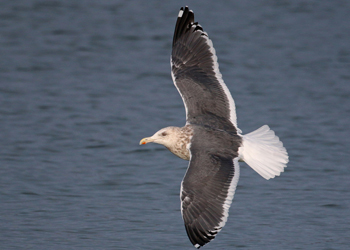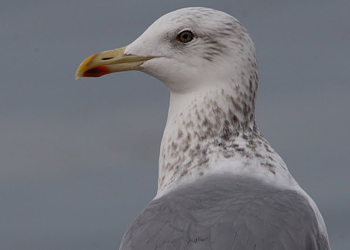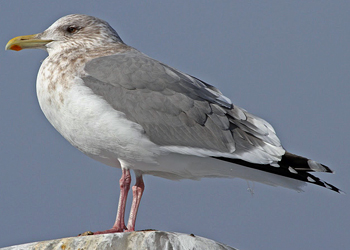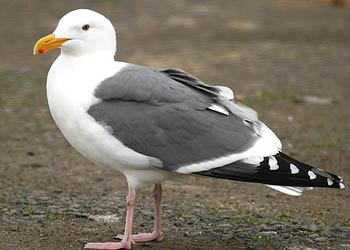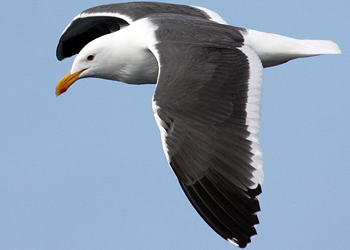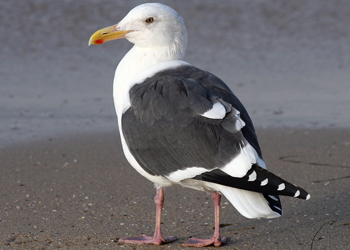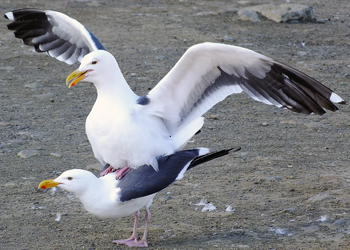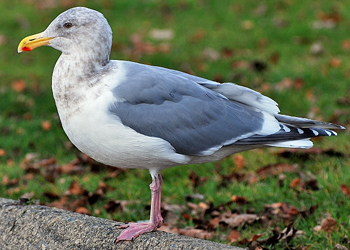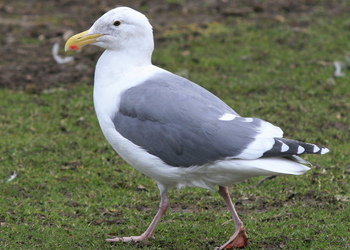 Slaty-backed Gull (schistisagus) / オオセグロカモメ / 큰재갈매기
Slaty-backed Gull (schistisagus) / オオセグロカモメ / 큰재갈매기
(last update: December 2015)
Slaty-backed Gull (schistisagus) sub-adult February
The immature birds on this page comprise two age classes: 3rd cycle (4CY February) birds and 4th cycle (5CY February) birds. Many birds can be aged correctly by combining adult-like and immature characteristics, however some retarded 4th cycle birds or advanced 3rd cycle birds are labelled "sub-adult".
3rd generation flight feathers in 3rd cycle birds. In general these are adult-like birds, with obvious immature markings. Ageing can be difficult at this age, especially between 3rd cycle and 4th cycle birds. Immature birds with extensive black in the tail and extensive brown wing-covert patches should normally also be in 3rd cycle. However, advanced 3rd cycle and retarded 4th cycle birds are extremely similar, and such birds are probably best labelled "sub-adult".
4th cycle birds are very adult-like, with single vestiges of immaturity, like dark centres on underwing primary coverts, dark centres in some secondaries or some black in the tail feathers. Remember that true adult Slaty-backed Gulls hardly develop black on the bill, hence birds that do show a black line on the bill are suspecious and should be checked for any immature characteristics (check white underwing on dark scalloped patterns!).
= = = = = = = = = = = = = = = = = = = = = = = = = = = = = = = = = = = = = = = = = = = = = = = = =
Below you will find a description of Chapter 30. SLATY-BACKED GULL, as published in one of the best Gull publication: "Gulls of the Americas" by Steve Howell & Jon Dunn.
"we" in the text below refers to the original authors. If any errors occur in this text, please let me know and mail to marsmuusseatgmaildotcom.
= = = = = = = = = = = = = = = = = = = = = = = = = = = = = = = = = = = = = = = = = = = = = = = = =
BACK TO PART 1: STATUS & DISTRIBUTION
BELOW PART 2: FIELD IDENTIFICATION OF SLATY-BACKED GULL SIMILAR SPECIES - ADULT CYCLE
No other dark-backed large gull occurs regularly in the Bering Sea region, but beware Vega Gull, which can look deceptively dark-backed when seen against ice or snow. Vagrants need to be separated with care from a variety of potential confusion species and hybrids (see Rarer Species and accounts for Slaty-backed Gull hybrids).
Note in Slaty-backed Gull the slaty gray tone of upperparts, wingtip contrast and pattern, and overall structure; also see Slaty-backed Gull hybrids.
VEGA GULL (w. Alaska) averages lighter in build with more slender bill. Upperparts medium gray (Kodak 7-8) but can look darker against ice; note distinct contrast between upperparts and black wingtip, both perched and in flight, and more contrasting black wingtip on underwing; eyes olive to dirty pale lemon.
WESTERN GULL (w. N. America, regular in se. Alaska) has upperparts slightly paler or similar in shade (Kodak 8-11), but white primary tips smaller at rest, bill more bulbous-tipped and typically brighter in winter (orange-yellow, without dark distal marks), orbital ring yellow, eyes often dusky, and, in winter, has little or no dusky head and neck streaking. Also note Western’s narrower white trailing edge to secondaries (true?), narrower and more restricted whitish tongue-tips and mirrors on outer primaries, and blackish underside to wingtip.
HYBRID GLAUCOUS-WINGED GULL X WESTERN GULL = "OLYMPIC GULL" (w. N. America) has paler upperparts (Kodak 6-8), typically a more bulbous-tipped bill, smaller white tongue-tips on outer primaries, and dusky (not brown-toned) and often smudgier basic head and neck markings.
CONTINUE PART 3: FIELD IDENTIFICATION OF SLATY-BACKED GULL, SIMILAR SPECIES - FIRST CYCLE
 Slaty-backed Gull (schistisagus) 3rd cycle (4CY), February 20 2014, Choshi, Chiba, Japan. Picture: Shiroto.
Slaty-backed Gull (schistisagus) 3rd cycle (4CY), February 20 2014, Choshi, Chiba, Japan. Picture: Shiroto.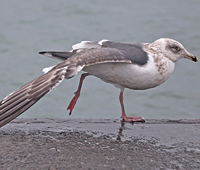 Slaty-backed Gull (schistisagus) 3rd cycle (4CY), February 19 2014, Akkeshi, Hokkaidoi, Japan.
Slaty-backed Gull (schistisagus) 3rd cycle (4CY), February 19 2014, Akkeshi, Hokkaidoi, Japan. Slaty-backed Gull (schistisagus) 4th cycle (5CY), February 18 2014, Choshi, Chiba, Japan. Picture: Shiroto.
Slaty-backed Gull (schistisagus) 4th cycle (5CY), February 18 2014, Choshi, Chiba, Japan. Picture: Shiroto. Slaty-backed Gull (schistisagus) 4th cycle (5CY), February 21 2014, Choshi, Chiba, Japan. Picture: Shiroto.
Slaty-backed Gull (schistisagus) 4th cycle (5CY), February 21 2014, Choshi, Chiba, Japan. Picture: Shiroto. Slaty-backed Gull (schistisagus) (sub?) adult, February 10 2009, Chijiwa, Nagasaki, Japan. Picture: Shiroto.
Slaty-backed Gull (schistisagus) (sub?) adult, February 10 2009, Chijiwa, Nagasaki, Japan. Picture: Shiroto.
